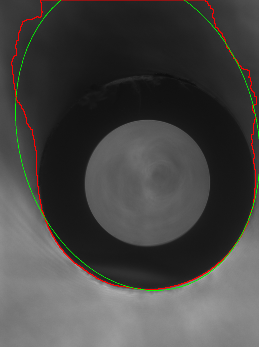I need to get two ellipses which will 'describe' my 'ring'.
I have the following code at the moment:
import cv2
import numpy as np
import imutils
image = cv2.imread('front2.png', cv2.IMREAD_COLOR)
# Convert to grayscale
gray = cv2.cvtColor(image, cv2.COLOR_BGR2GRAY)
_, gray = cv2.threshold(gray, 50, 255, cv2.THRESH_BINARY)
# Downsize image (by factor 4) to speed up morphological operations
gray = cv2.resize(gray, dsize=(0, 0), fx=0.25, fy=0.25)
cv2.imshow("Gray resized", gray)
cv2.imwrite('Gray_resized.png', gray)
# Morphological opening: Get rid of the stuff at the top of the ellipse
gray = cv2.morphologyEx(gray, cv2.MORPH_OPEN, cv2.getStructuringElement(cv2.MORPH_ELLIPSE, (5, 5)))
cv2.imshow("Gray removed noise", gray)
cv2.imwrite('Gray_removed_noise.png', gray)
# Resize image to original size
gray = cv2.resize(gray, dsize=(image.shape[1], image.shape[0]))
# Find contours
cnts, _ = cv2.findContours(gray, cv2.RETR_EXTERNAL, cv2.CHAIN_APPROX_NONE)
# Draw found contours in input image
image = cv2.drawContours(image, cnts, -1, (0, 0, 255), 2)
if len(cnts) != 0:
for cont in cnts:
if cont.size < 10 or cv2.contourArea(cont) < 100:
continue
elps = cv2.fitEllipse(cont)
cv2.ellipse(image,elps,(0,255,0),2)
# Downsize image
out_image = cv2.resize(image, dsize=(0, 0), fx=0.25, fy=0.25)
cv2.imshow("Output image", out_image)
cv2.imwrite('Output_image.png', out_image)
I've got images like:
In this way it detected one ellipse well enough but it hasn't detected the second one.
As i read it'd be more logical to use 'cv2.THRESH_BINARY_INV' in threshold but in this way it doesn't detect ellipse in the center:
Also if i try to lower the threshold my ring starts to fade:
The main questions: How to get rid of this noise at the top of my ring for detecting contours? And how to detect these ellipses?
I've looked at these answers: 1st 2nd 3rd but i haven't managed to achive my goal.
P.S. I can't use Hough-Circle method here. Because i have few similar images and radius for 'x' and 'y' axis may different and i need this precision(it means i need only ellipses and their radiuses for two axises).







